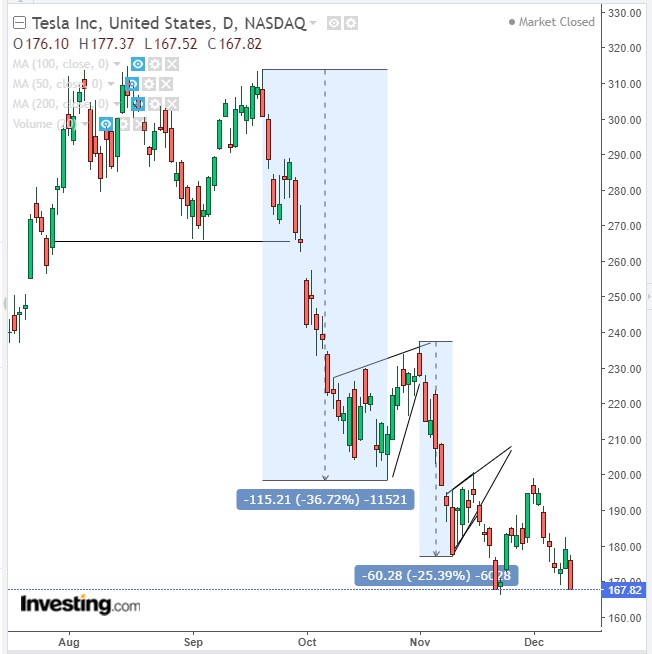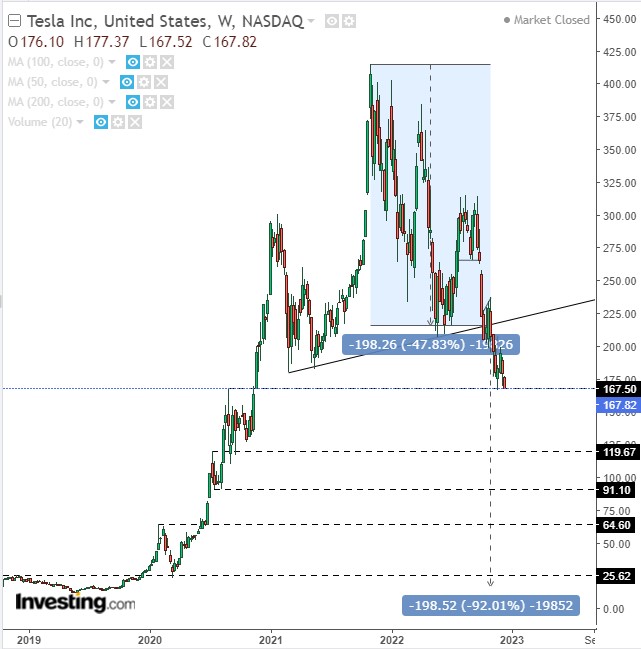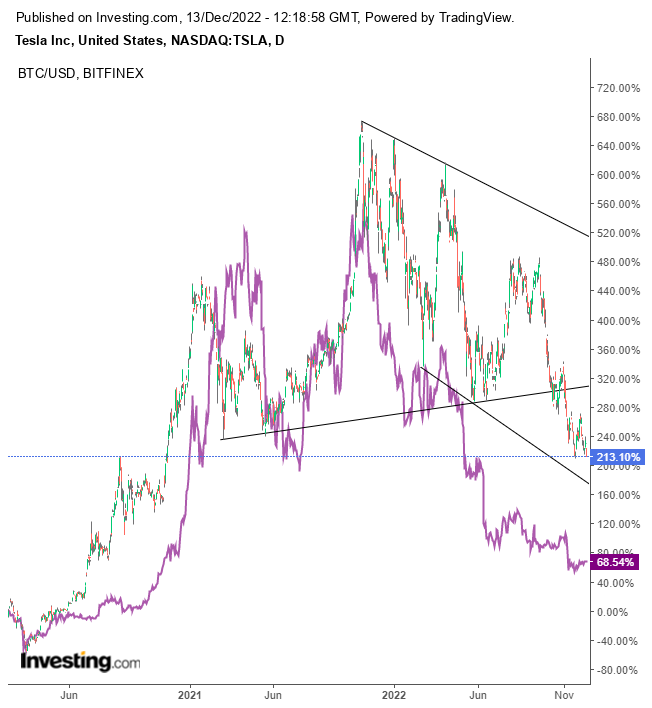Chart of the Day: Is Tesla About to Be Annihilated?
2022.12.13 12:03
[ad_1]
- Tesla has lost 52% of its market value this year
- On the technical chart, we see three consecutive bearish patterns
- Could Tesla’s fallout be equally aberrant to its meteoric rise?
Tesla (NASDAQ:) is a global company best known for its electric vehicles (EVs), but it also generates income from other sources, such as energy storage and regulatory credits.
In 2021, the Austin, Texas-based behemoth had a net income of $5.51 billion, marking a 665% increase from its net income of $721 million in 2020. This growth was primarily due to the success of the company’s car business, which has finally become profitable after 17 years, and the sale of regulatory emissions credits.
Tesla earns these credits by producing EVs instead of gas cars, and gas automakers can buy them directly from Tesla if they fall short of low- and zero-emission production requirements. In the second quarter of 2021, Tesla generated around $344 million in revenue from these credits. However, this source of income may eventually decline as other automakers begin producing their own EVs at scale.
Rivian Automotive (NASDAQ:) is an electric vehicle (EV) startup that designs, manufactures, and sells high-end electric SUVs and pickup trucks. The company recently started delivering units of its first model, the R1T electric pickup truck, and is planning to deliver its second model, the R1S electric SUV, later this year.
Rivian is considered one of the world’s most technologically advanced and promising EV makers. The company has received significant investments from Amazon (NASDAQ:) and Ford (NYSE:) and has partnerships with the likes of Campbell Soup (NYSE:) and outdoor retailer REI. Some analysts believe Rivian’s innovative technology and partnerships make it a strong contender in the EV market and a potential “Tesla-killer.”

We see three consecutive bearish patterns: a double top and two flags.
A rising flag is a range created by early bears who lock profits after a sharp drop and new bears who want to ride the downtrend. The downside breakout completes the pattern, demonstrating that sellers are willing to reduce offers to find more demanding buyers at lower levels. That breakout is expected to trigger a technical chain reaction and repeat the flagpole, the initial selloff.
The first flag’s expected move is a $115 decline from the $225 breakout point, targeting $110. The second flag’s implied target is another $60 drop, as the supply-demand balance statistically gets sucked into a series of market orders from the $190 breakout, indicating a $130 target.
However, there is something much more worrisome happening.

Tesla Weekly Chart
From this point, we realize that the triple bearish chart is merely a tiny part of a much larger pattern – an ominous H&S pattern so large it is scary. This pattern encapsulates buyers’ capitulation. The left shoulder and head are the rising peaks in the uptrend. The right shoulder, peaking below the head, is the failure to sustain the uptrend.
Statistically, an H&S top repeats its height below the breakout. However, this H&S is at such a large scale relative to its initial ascent that a follow-through would almost erase its entire uptrend’s gains. The height is nearly $200, suggesting a potential return to $18.
Naturally, this target challenges the principle upon which it stands. In other words, it sounds ludicrous. However, there are promising statistics in defense of this body of knowledge. The performance above the S&P 500 buy-and-hold for tops was 19% for tops, and for bottoms, 25% (Bulkowski, 2000). The failure rates for both top and bottom formations are meager. Only 10% failed a 10% gain or more from bottoms, and 18% failed a 10% gain from tops.
However, tops of such an abnormal scale are something I have never seen before, which made me think that they are market aberrations in the artificial economy, a decade of QE followed by pumping unprecedented stimulus of COVID policy.
But if the setup was an aberration, does that not mean that the fallout could be equally aberrant?
Moreover, Tesla’s stock positively correlates with another freak, .
 Tesla Vs. Bitcoin Daily Chart
Tesla Vs. Bitcoin Daily Chart
Observe the meteoric rise and fall of BTC. is my analysis of BTC, predicting the beginning of the year of its virtual wipeout. Remember, at the time, consensus – institutions included – called for $100K, $250K, and $1M in the “to the moon” frenzy. Bitcoin is now valued at almost a third since my call.
Moreover, is my article on the relationship between the two assets.
In conclusion, technical analysis is a statistics-based analysis. Its practitioner attempts to gauge the balance of supply and demand. I don’t know the future. I don’t know that Tesla is going to its 2017-2018 prices before the cataclysmic rise, nor should you trade that way. A trader must account for the complete picture. Accordingly, I marked potential bullish strongholds to incorporate into your outlook (Support lines).
Trading Strategies
Conservative traders should wait for the price to fall below the Nov 22 low, then rise to confirm newfound resistance before shorting.
Moderate traders would short if the price rebounds toward the $200 resistance (Oct low-Nov high + psychological round number) and demonstrates resistance. Alternatively, upon the rally that follows, the next dip below the Nov 22 low.
Aggressive traders could enter a contrarian long, relying on the Nov 22 support, taking advantage of its proximity, before joining moderate peers with a short.
Trade Sample – Contrarian Aggressive Long
- Enter: $168
- Stop-Loss: $165
- Risk: $3
- Target: $198
- Reward: $30
- Risk-Reward Ratio: 1:10
Disclosure: The author does not own any of the securities mentioned in this article.
[ad_2]







